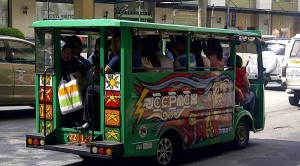
The LTRFRB has “approved the franchises of the first 20 e-jeepneys, which will ply three different Makati Green Routes namely: Legaspi Village, Salcedo Village, and Heritage Village loops,” Department of Transportation and Communications (DOTC) Undersecretary Efren Moncupa said in a statement released Friday.
The LTFRB has begun offering franchises to e-jeepneys, which run using electricity instead of diesel resulting to cost savings and cleaner air, Moncupa said.
“With this, the Pinoy jeepney, which has been a boon to the Filipino culture but a bane to the environment for its reputation of being a smokebelcher, is set to get a much-needed reinvention, one that would make it more eco-friendly,” he said.
Transport group, Pasang Masda, was approached by the DOTC “to convince their members to switch to these environmentally-friendly modes of transport.”
“The group is proposing (the adoption of) a 21-seater e-jeepney that costs around P450,000 to P500,000,” Moncupa said in the statement.
The DOTC was also looking to fit jeepneys with Liquefied Petroleum Gas (LPG) engines, which it described as more “efficient and eco-friendly.”
To further help the reduction of air pollution, the DOTC said it was studying reducing the age limit of Public Utility Vehicles.
“Currently, buses have a 15-year old age limit; taxis, 13 years; and AUVs, multicab, and vans, 10 years,” DOTC said.
DOTC spokesperson Nic Conti said that the agency’s move to shift to electronic and LPG jeepneys was part of the drive to lower the level of Total Suspended Particulates (TSP), which is the measure used for air pollution.
“As it is, the country already recorded a 30 percent drop in the amount of total suspended particulates from 166 µg/Ncm (micrograms per normal cubic meter) in June 2010, to 116 µg/Ncm towards as of end of last year,” he said in the statement.
“With these initiatives, as well as the LTO’s continued implementation of vehicle emission standards set by the Department of Environment and Natural Resources, we should be on our way to the normal standard set for TSP by the World Health Organization, which is 90 µg/Ncm,” he said.